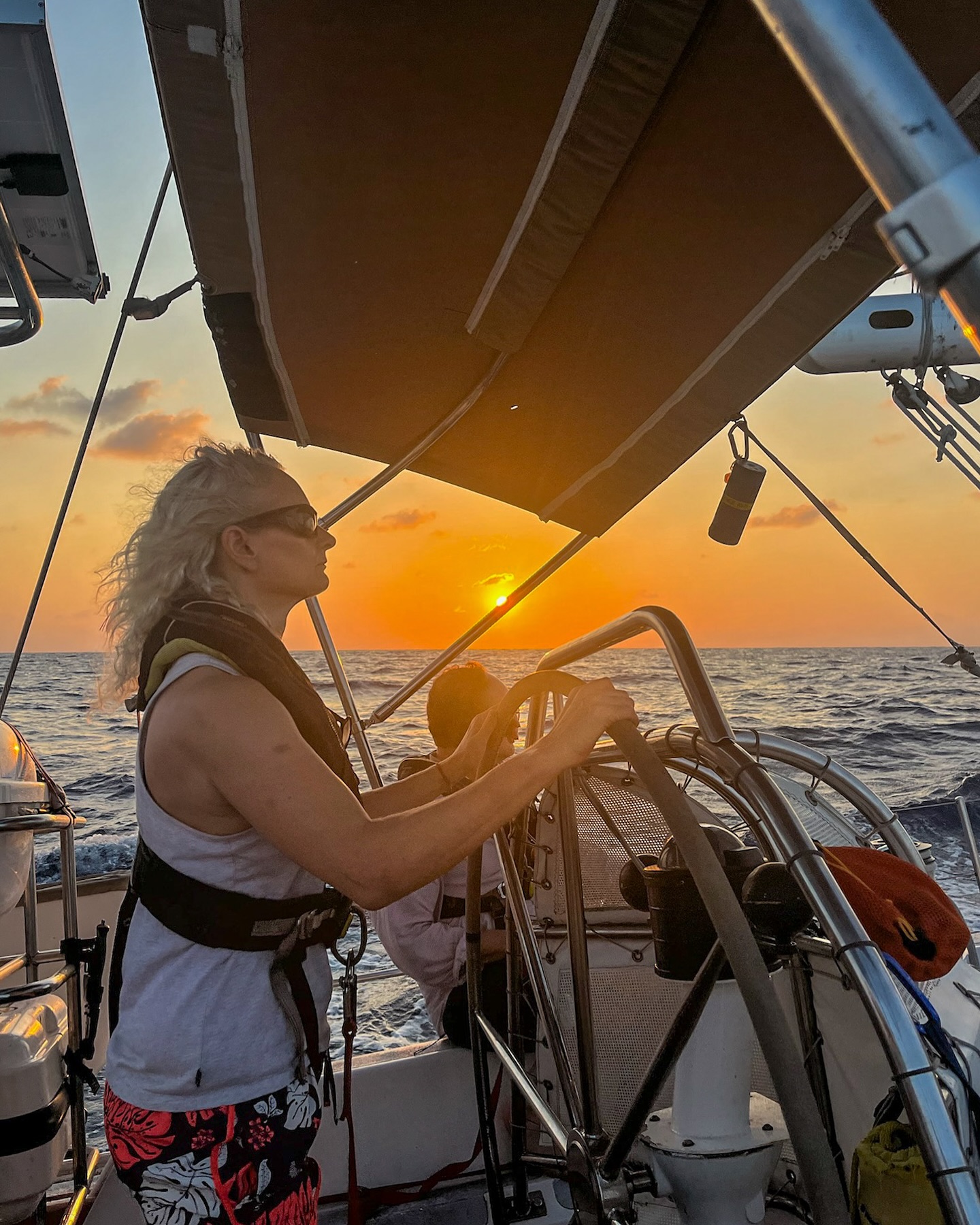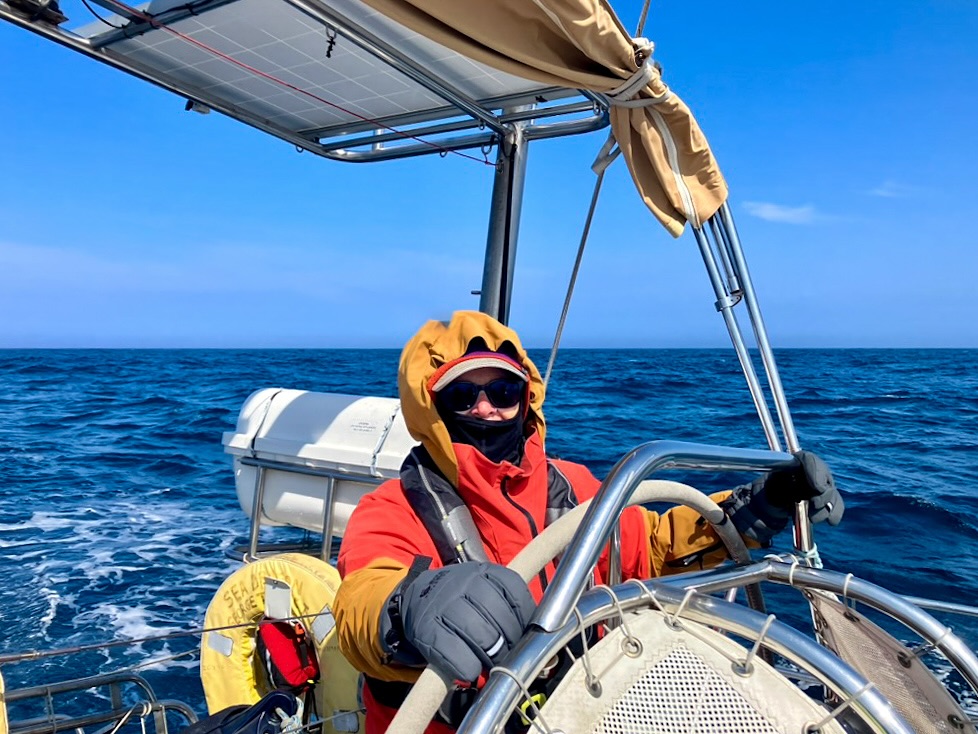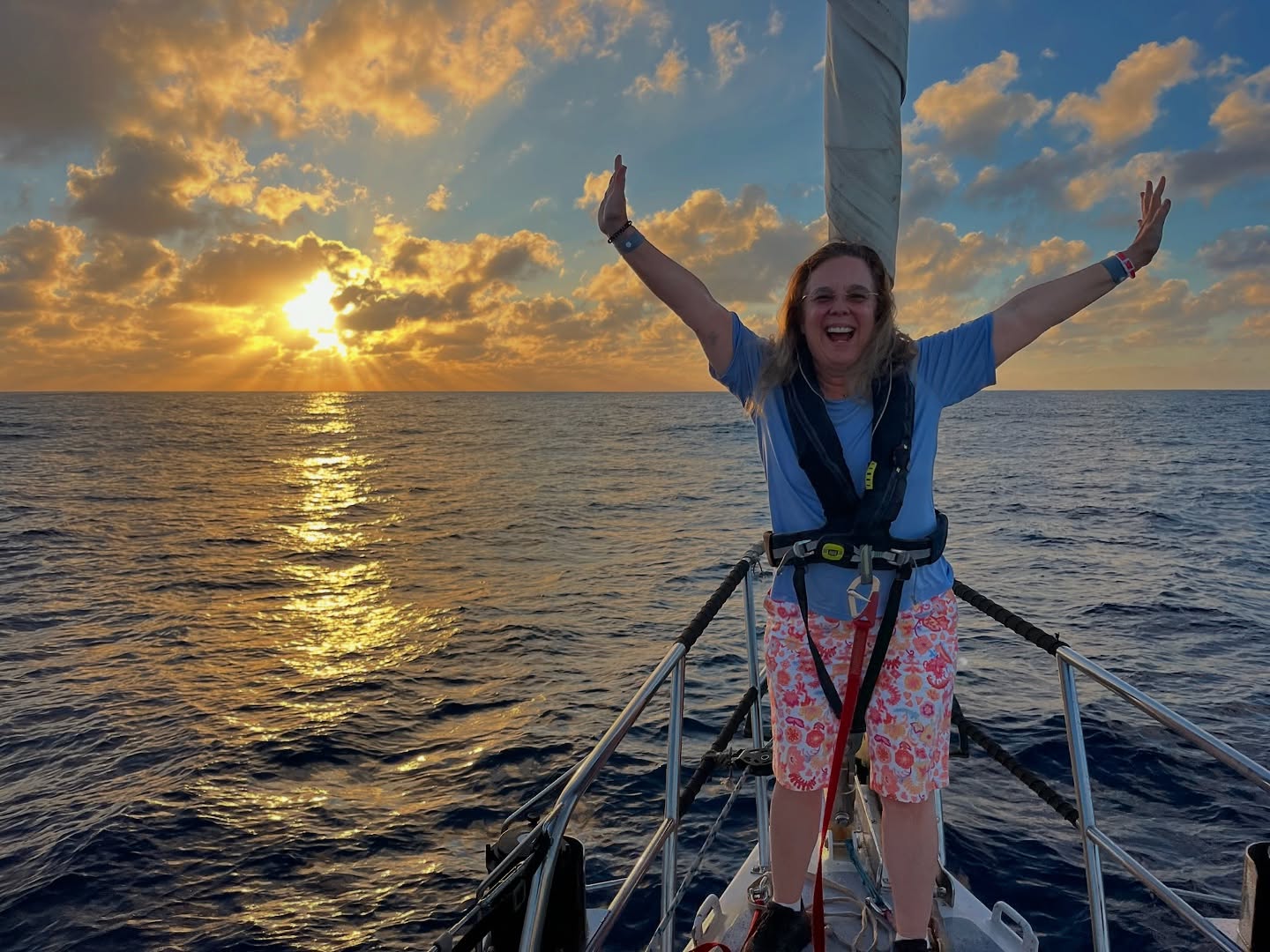Hello from the sweltering tropics! Meret (my onboard upgrade/replacement) wrote this lovely blog. I (Sarah) will be heading home to the frigid northlands of Minnesota once we get back to Hawaii! And with no further ado…
It’s silent on the boat. The quiet feels unusual after the bustle of the last trip – lovely as it was. We‘re all just enjoying the peace and quiet. Between cleaning the boat and doing multiple man overboard drills to perfect the procedures, everyone catches up on laundry or reads in one of the many hammocks. Periodically hopping into the turquoise water is the only way to keep body temperatures at a bearable level.
We’re in Kiritimati, actually pronounced “Christmas”, in the country of Kiribati, pronounced “Kiribas”, as “ti” is pronounced “s” in the Kiribati language.
Christmas Island, or Kiritimati, seemed busy after the calm of Palmyra. Around 8000 people live here. The island has four towns (London, Paris, Poland and Banana) with paved roads, one ATM, and several shops. The shops sell anything from Spam to one gallon tubs of ice cream to ready made cake mix to SIM cards. Some of us try walking to London, the closest town, but in the sweltering heat only those who catch a ride in the open back trucks make it all the way to the center. Oddly, the currency here is Australian dollars. It has to do with the aid and development work on the island that Australia and New Zealand support. This is actually the largest atoll in the world, in terms of land mass, so the government has been relocating people here from Tarawa to combat over crowding and because it is at a less imminent risk of being overtaken by sea level rise than many of the other islands of Kiribati. There are a few hotels here that cater to fly fishermen in search of bonefish who arrive on the weekly flight, but the economy of the island, such as it is, largely runs on exported goods. Next to the export of dried coconut, known as copra, another export is vibrantly coloured fish for the aquarium trade.

Fun fact about Christmas Island: it was the very first place to see the sun rise in the new millennium. While it is in the same time zone as Hawaii, it’s a day ahead! The capital of Kiribati, Tarawa, is on the opposite side of the date line, so for business’ sake, the entire country is on the same calendar day. Yes, it’s confusing! And worry not -we have had plenty of conversations ending in utter befuddlement on what day it currently is or isn’t. None of us really know what day it is anymore but it certainly makes time travel feel almost possible.
Crescentia from the last trip decided to crew with us a little longer, making our current headcount on board 6: Eric and Shanley, who run this lovely vessel and patiently teach us the ways of the high seas and keep us in check; Mary, our lil‘ Texan super scientist and deckhand, who we have named a weather scale after and who answers all our random biology related questions; Sarah, deckhand #1, who does a hilarious old British granny impression (it mainly comes out on night watch or during squalls); Crescentia, our master chef on board, who keeps our culinary desires fully satisfied and who has a never ending supply of stories to tell; and me, Meret deckhand #2 who always tries to help but invariably makes everything 10x more complicated.

We set sail from Christmas Island mid day in calm weather. For a few hours we managed to sail with a gentle 12 knot breeze pushing us along from behind. Once it died down, we motored the rest of the 24 hour journey to Fanning Island, also known as Tabuaeran. As gentle as the wind was, our wildlife sightings were low, apart from the occasional seabirds such as sooty terns, frigate birds, tropic birds or boobies here and there. Though we fell into a watch system for the trip, its short duration meant our bodies and minds didn’t quite settle into the routine as they would on longer trips.

Approaching Fanning is remarkably similar to Palmyra in terms of the lush green tree cover on the island. The main difference is the size of the island (this being bigger) and that, as we flake our main and furl the jib, we can see a village made up of corrugated iron houses with steep roofs.
To enter the lagoon we have to navigate a narrow channel with a strong current. Big waves are breaking across the reefs either side of us. Shanley, part of the way up the mast, directs Eric, our helmsman, around the shallow areas. Once in the large lagoon of the atoll we are surprised to be in deeper waters than expected. We anchor and drop the dinghy to do some depth soundings. As we circle the little bay by the village pier we continue to find none of it shallower than 18ft. All the charts seem to be completely off, although admittedly the soundings are from 1897, with a few updates to the topography and reef flats from 2013.
We settle and call the Fanning boarding party. The customs officials do an extensive search of the boat, looking for who knows what, but eventually give us the all clear. They also tell us a tad about the island and inform us the mooring buoy off the pier is good to use – they actually recommend using it. After further depth soundings around the buoy and a free dive to the bottom by Eric, he deems it safe. We relocate closer to the pier and the big field where a football tournament between the local secondary schools is happening. We can see kids dressed in green or red running from one end to the other accompanied by the occasional commentary.
Like Kiritimati, Tabuaeran is one of the Islands in the Line Islands, a group of islands along the equator that are all part of Kiribati. It has 2000 inhabitants that live in several villages mainly on the Western side of the lagoon. The Eastern side is uninhabited and filled with coconut palms, from which they harvest copra. Apart from copra the island also dries seaweed, which it sells to the government (our source wasn’t sure what for). To get across the lagoon you have two choices: a small motorized boat or one of the local sailing canoes.

On one of our wanders on the island we found row after row of taro plants. They grow in dugout pools with their roots submerged. Supply ships from the outside world come rarely, so most people live on what they can grow and catch themselves – fish, breadfruit, coconut, taro, sugarcane, honey, chickens, and a few pigs for holidays and feasts. There is one surf camp here owned by a Frenchman named Bruno. When we visited there were a few Australian tourists who had come here to fish and surf, flying in to the recently built air strip, though flights are both expensive ($11,000 one way) and notoriously unreliable.
As a former British colony independence day, coming up on the 12th of July, is a cause for big celebrations. There are parades, football tournaments, sail canoe races across the lagoon and back, gardening competitions, bingo tournaments and lots of music. We are all a little sad to be missing it by a few days.
Everyone here is very friendly and I am surprised by the high level of English. I particularly enjoy the reaction of the children to us stomping across their island. Half are all smiles and shout and wave at us, the other half look at us mistrustingly with big frowns on their faces. They must be wondering who on earth we are and what we are doing here. Though it still must be a less bizarre sight than when cruise ships with 2000 guests turn up and offload a hoard of predominantly white people for a brief look around the island. They have about four of these visits a year, the last was in March. In terms of sailboats, the numbers here are the same as Christmas Island, which also had 5 visit so far this year.
Here as in Christmas Island, the turquoise color of the water in the lagoon is reflected on the bottom of the clouds, painting them a distinct blue-green-grey colour.
The pace of life here seems a lot calmer than Christmas. And everyone seems to smile easily and frequently. Setting up a slackline certainly had a bunch of children giggling and laughing for the longest time as they tried to balance across it.
It’s nice to have a similar crew to the last trip, it means you get to know each other real well. Maybe a little too well… being confined to the small area of this boat. But it does means we are getting very good at executing maneuvers as a team. This was beautifully demonstrated as we smoothly sailed off our mooring and headed towards Hawaii.
As we left the luscious green island atoll with its happy inhabitants and the turquoise lagoon clouds astern, we prepared for a squally, bumpy, upwind sail to Hawaii. Catch you there in a week or so!
























